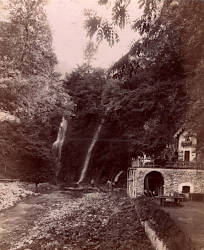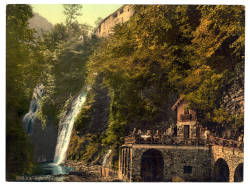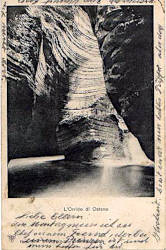L’Orrido di Osteno
Useful Information

| Location: |
SP14, 2, 22010 Osteno-Claino CO.
(46.005563, 9.084802) |
| Open: |
no restrictions. [2022] |
| Fee: |
free. [2022] |
| Classification: |
 Gorge Gorge
|
| Light: | n/a |
| Dimension: | |
| Guided tours: | self guided |
| Photography: | allowed |
| Accessibility: | no |
| Bibliography: |
Antonio Fogazzaro (1881):
Malombra
|
| Address: | L’Orrido di Osteno, SP14, 2, 22010 Osteno-claino CO. |
| As far as we know this information was accurate when it was published (see years in brackets), but may have changed since then. Please check rates and details directly with the companies in question if you need more recent info. |
|
History
Description


L’Orrido di Osteno (Ravine of Osteno) is a gorge which ends at a waterfall of the stream called Telo di Osteno. The gorge is also called Orrido della Pescara (Ravine of Pescara). Waterfalls are quite common in the Alps, and this one is not special, but the fact that it is visited by boat, floating upriver through the gorge until the waterfall is finally reached, is quite exceptional. It became popular in the 19th century and was mentioned by Luigi Pirandello in the poem Lago di Lugano. The site was described in a book by the local author Antonio Fogazzaro (*1842-✝1911) as he set a scene of suicides here at the waterfall in his novel Malombra. It is a 19th century Gothic story set close to Lake Como and was his debut novel. Fogazzaro was born in Vicenza and was nominated for the Nobel Prize in Literature seven times. While the book is almost unknown outside Italy, it was turned into films twice and there was also a TV miniseries in 1974 in Italy. It seems there is also an erotic version from 1984, which is even on Amazon Prime. However, the waterfall is only in the original novel.
The Horror is only a few hundred yards from the village.
The river rises a few miles higher up, the waters gather in bulk among the wild caves between the sloping sides of two mountains, then the river runs smoothly in the open for a brief distance, and then, near the village, falls from cascade to cascade till it reaches the end of the valley, and feebly expires in the lake at the point where the present company left their boats.
...
Soon after this the river makes a bend.
No more sunshine, no more verdure, no more laughing waters ; huge jaws of stone stand gaping wide open before you, causing you to halt when you hear the deep roar that issues from them, and feel the cold breath of that dark and mon strous gullet.
The roar comes from the very entrails of the earth ; the water passes through that rocky mouth in a dark, voluminous, but silent stream.
A small leaky boat is here, chained to a ring fastened to the rock.
It can carry two persons in addition to the boatman.
One goes up the stream in this little boat, which apparently has no desire for the task.
It twists its head now to the right, now to the left, and would slip away down the stream but for Charon’s pole.
The uproar increases, the light begins to fail.
The boat passes between two lines of black rocks, enormous stalactites, here in swell ing outline like some weird forest growth ; there hollow, dripping, like inverted heads ; but all in rows, at equal intervals, carved from base to summit with spiral lines.
High above, the sky seems to shrink smaller and smaller between the rocks, till it finally disappers.
The little boat enters a dark chasm which resounds with howls ; it quivers from stern to stem, dashes against the rock on the right, dashes against it on the left, mad with terror, under the echoing arches of rock, whose entrails are gnawed away by the swiftly - flowing stream, and which rise, twisting and contorted, upwards.
From the narrow rent in the leafy mantle of these rocks a greenish gleam, a spectral light which tinges the jutting points of rock, grows fainter as it passes from stone to stone, and dies away before reaching the dark green water beneath ; it is like a ray of moonlight half hidden in clouds at daybreak.
Through this gallery one enters the throne room, ’ a round, gloomy chamber with a mass of rock in the centre, like a rough pulpit or reading - desk for low Mass, standing upright between two enormous clouds of foaming water which encircle its sides, and stream on into a wide passage, all roar and flying mist, like two express trains passing side by side through a tunnel.
It is from that rocky mass that the cavern takes its name of the throne room.
One thinks of some prince of dark ness seated upon that throne, lost in meditation, his glance fixed on the deep waters full of woe and wail ing, full of tortured souls.
Through a fissure behind the throne a bright jet of light irradiates the cave.
Antonio Fogazzaro (1881):
Malombra
Orrido may be literally translated horrid or horror, thats why it was translated as Horror in above excerpt. The site was obviously ignored by the locals for centuries, it was of no practical use. It became popular in the 19th century, when tourism increased and romanticism looked for spectacular nature spots. At one point there were regular boat rides at the site and a restaurant, but it was discontinued, sometimes in the 1980s. For some years there was a local initiative to reactivate the site and open it to tourists. As far as we know this never happened. Currently, the site is neglected and there are neither restrictions nor any infrastructure, the restaurant is ruined. So we guess you have to walk and swim to see the gorge and waterfall. The site is mentioned on canyoning websites. As it is now privately owned, if you see someone it’s probably the owner, and you should ask politely.
The Orrido is located at the border between Switzerland and Italy, only 4.5 km from the border. On the tow old postcards we have on this page it is stated that it was located in Tessin in Switzerland. The current border is a product of the Napoleonic period, established with the provisional constitution of the Helvetic Republic of 15 January 1798. It has not changed since then, so this is simply a typo or misunderstanding, probably a result of the fact that nearby Lago di Lugano is mostly in Switzerland.
- See also
 Search DuckDuckGo for "L’Orrido di Osteno"
Search DuckDuckGo for "L’Orrido di Osteno" Google Earth Placemark
Google Earth Placemark Orrido di Osteno
Orrido di Osteno  (visited: 15-OCT-2022)
(visited: 15-OCT-2022) Orrido della Pescara (visited: 15-OCT-2022)
Orrido della Pescara (visited: 15-OCT-2022) RITORNO AL PASSATO: ORRIDO DI OSTENO - CLAINO CON OSTENO (CO)
RITORNO AL PASSATO: ORRIDO DI OSTENO - CLAINO CON OSTENO (CO)  (visited: 15-OCT-2022)
(visited: 15-OCT-2022) Orrido di Osteno, Valle di Ponna, Lirone inf.
Orrido di Osteno, Valle di Ponna, Lirone inf.  (visited: 15-OCT-2022)
(visited: 15-OCT-2022)
 Index
Index Topics
Topics Hierarchical
Hierarchical Countries
Countries Maps
Maps